Keep Your Dog Safe
By Michele Welton, Dog Trainer, Breed Selection Consultant, Author of 15 Dog Books
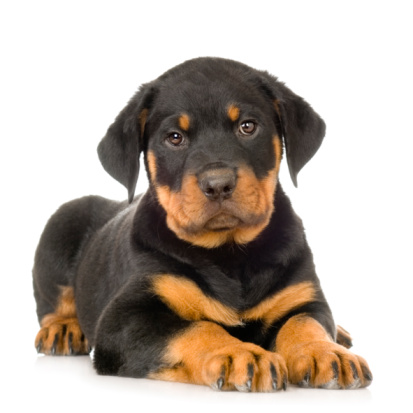
Rottweiler puppy
If you've been following my free health care program from the beginning, we've talked about keeping your dog healthy by:
1) feeding real food
2) minimizing vaccinations
3) protecting his immune system by providing a non-toxic environment
4) preventing fleas, ticks, and heartworm
5) keeping his body and mind fit through physical exercise & mental stimulation
6) providing emotional security so he feels calm and relaxed
Now it's time to face a grim fact.
All of this time and effort can be undone in the twinkling of any eye if you lose your dog to some tragic accident. It only takes an instant for a dog to squeeze through a gap in your fence and be lost, to dash through an open door and be hit by a car, to drown in a pool, to choke on a tiny ball, to snatch a cooked chicken wing from the kitchen counter, to be attacked by another dog, to fall from an upstairs deck, to be stolen from your yard, to be flung through the windshield of your car during a crash.
The sheer number of bad things that can happen to your dog is sobering, but what's more sobering is that almost all of those things are preventable.
Yet they happen every day to someone's dog. Usually because that owner didn't realize that something in their dog's environment was an accident waiting to happen. And one day, sure enough, it did.
Where safety is involved, a strong immune system won't do your dog any good. As responsible guardians, we need to open our eyes really wide and observe everything going on around our dogs. Is that safe? Is that? What about that?
If there's anything in his environment that isn't safe, we should change it right now to prevent tragedy from ever happening.
And we need to keep on doing that for the rest of our dog's life. Because raising a dog is like raising a toddler.... except that a dog never grows up.
Like toddlers, dogs are curious and impulsive. They run in every direction, oblivious to danger. They poke and prod and explore with their mouth.
Raising a dog is like raising a toddler who never grows up.
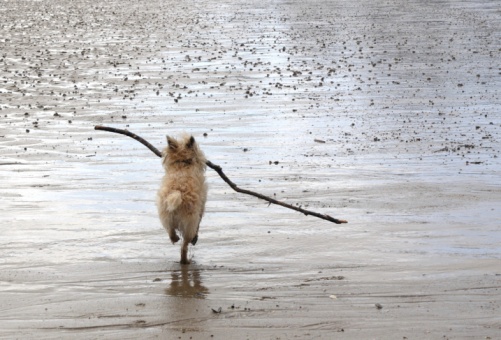
Table of Contents
Safety in your living/family room
Safety in your yard and garden
Safety on your driveway and walkways
Safety around strangers and other dogs
Safety around cats & other animals
Safety when you visit friends and relatives
Safety when friends and relatives visit YOU
Protect your dog from being stolen
Safety during natural disasters
What happens to your dog if YOU die or are seriously injured
Escape proofing your yard
 Do all dogs need a fenced yard?
Do all dogs need a fenced yard?
In my opinion, yes. All dogs should have a fenced yard in which to stretch their legs and run around a little, every day.
Dogs who run loose are hit by cars. Poisoned, accidentally or on purpose. Stolen. Injured or killed by other dogs. Caught in animal traps.
Dogs who run loose CAUSE accidents by dashing across the street and forcing drivers to swerve wildly.
I don't believe anyone reading this article would let their dog run loose, but in case you know someone who does, they're being utterly irresponsible, both to the dog and to other people.
See my other articles on outdoor confinement:
- Do dogs need a fenced yard? – includes regular fencing, modular pens, swivel stake tethers, cable/pulley systems, and invisible fences
- Best and worst fencing options for dogs – includes privacy fences, chain link, wire mesh, pickets, and wrought iron
- Doggy door leading to small potty yard
Escapes may be intentional or accidental
Some escapes are deliberate. Your dog jumps or scrambles over the fence. He digs under or chews through. He opens the gate latch with his nose or paw. However he manages it, he tried to get out and now he's gone.
Dogs escape deliberately because they're bored or lonely, because they're tempted by something outside the fence (another dog or a squirrel), or because they're frightened (thunderstorm or fireworks).
Other escapes are accidental/opportunistic. Someone leaves the door or gate ajar. A child on a bicycle crashes into your fence, a board shatters, and your dog wanders through the gap. Down the driveway, across the street, and now he's gone.
To prevent escapes:
- Know your own dog. Some dogs are clever escape artists who will go over, under, or through fences, gates, and doors. Other dogs seem to be homebodies – but then again, perhaps the chance hasn't yet presented itself, or the right temptation hasn't come along.
Some of the most notorious escape artists include Siberian Huskies, Shiba Inus, Basenjis, Border Collies, Miniature Pinschers (small, yes, but incredibly agile and clever), Jack Russells (and other terriers), and Beagles.
- Build appropriate fences for your particular dog.
6-foot fences are safest for medium to large dogs, although some tall dogs will stay happily behind a 4-foot fence, while some small dogs will amaze (and dismay!) you by scrambling over a 7-foot fence.
A solid fence is safest. If your dog can't see out, he is less likely to bark at things. If strangers can't see in, they are less likely to steal your dog. If kids can't see in, they are less likely to tease your dog. If passing dogs can't see in, they won't fence-fight with your dog. And solid fencing is harder to climb than wire or chain link. Pickets may also deter jumping, but they can be dangerous if a daring jumper tries to clear them – but misses.
- Are there low sections in the fence where your dog might be more tempted to jump? Are there any objects close to the fence (a tree stump or heavy-duty storage container) that your dog might scramble onto and use as a springboard?
- For serious jumpers and climbers, you may need to install an overhang around the top of the fence. This consists of 12- to 18-inch steel extension bars attached to the top of the fence, angled inward at 45-degrees, and strung with chicken wire. Think of prison yard containment.
Some determined dogs can only be secured in an enclosure completely roofed over with wire mesh.
 Can your dog dig under? Walk around the inside perimeter and study the bottom of the fence where it meets the ground. Some dogs can crawl under a surprisingly small gap.
Can your dog dig under? Walk around the inside perimeter and study the bottom of the fence where it meets the ground. Some dogs can crawl under a surprisingly small gap.
To deter serious diggers, line the inside perimeter with landscape timbers or patio blocks. Or dig a narrow trench along the inside perimeter, then fill it with concrete or attach a strip of chicken wire or garden fencing to the bottom of the fence, burying the lowest few inches in the trench.
 Can your dog squeeze through? If your fence is slats or pickets, make sure the spacing is narrow enough. If necessary, run a strip of small-mesh chicken wire or garden fencing across the slats.
Can your dog squeeze through? If your fence is slats or pickets, make sure the spacing is narrow enough. If necessary, run a strip of small-mesh chicken wire or garden fencing across the slats.- Are your gates secure? More dogs escape through gates than by any other route. Self-closing gates are great, but might lull you into assuming that if a gate closes, it always latches. Not true! Also remember that latches have two parts: one attaches to the gate, the other attaches to the gatepost.
Make sure BOTH of these are firmly attached. Check periodically for loose screws or rotting wood. You might even opt for a double latch, especially if you have a dog who jumps against the gate. If one latch breaks down, the other is still there.
Close everything behind you! Double-check to be sure everything has latched. Get into the habit of asking: "Are all of our doors closed? Are all of our gates closed? Where is my dog right now?"
Finally, don't put your dog in a position to escape. Don't leave your dog outdoors unless you're home AND watching him.
Escape-proofing your house
Do all the doors of your house open into a fenced yard? If so, then even if your dog gets through the door, he'll still be safely confined in the yard.
But if you have a door that doesn't open into a fenced yard, I recommend that you add a screen/storm door to it, as a back-up barrier. That way, when you open the main door, your dog is still behind the screen/storm.
Beware of screen doors alone. On a pleasant day, it's tempting to leave your front door open and let fresh air in through the screen. But with screen doors that go all the way to the floor, this can be risky, as a clever dog might push open (or chew through) the screen in order to get to passing people, other dogs, or a squirrel. Again, you must know your own dog.
If you do trust a screen door to confine your dog, latch it tightly. Lock the latch. And DON'T trust your dog behind only a screen door when you leave the house.
Don't leave windows open if they have no screens and are within your dog's reach. Even if they do have screens, if you have a determined escape artist, don't tempt him! He could decide to smash through the screen to get to something tempting such as another dog or cat or squirrel.
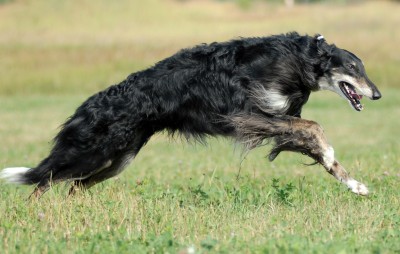
Borzoi, a large sighthound with a high prey drive
Safety in the kitchen
- Aside from cleaning products that irritate your dog's eyes, respiratory system, skin, and paws, the biggest dangers in kitchens are HEAT and DROPPED COOKWARE.
- A dog underfoot could get burned by splattered fat or sauce, cut by a knife you knock off the counter, or hit on the head by a dropped pot.
- Don't prop a small appliance on the edge of the counter with its electrical cord hanging down such that your dog could accidentally pull on the cord and bring down the appliance.
- Keep your wastebasket under the sink or behind a closed pantry door, or use a heavy barrel with a snap-tight lid.
- Food left within reach makes a tempting target. Small dogs are not exempt from this caution – plenty of small dogs will jump onto a chair and then onto the table to sample the food.
- Most kitchens have a slippery floor of vinyl or tile on which your dog should not be allowed to romp vigorously. Sliding on a slick surface can cause ligament and joint injuries, in all dogs, but especially in youngsters whose bones and joints are still growing, and in older dogs whose joints are arthritic.
Play active games only on carpets. If your whole house is vinyl or hardwood, add large area rugs for traction.
- Don't spray insecticide along your baseboards or set ant traps on the floor where the dog can reach them.
- Make sure cupboard doors close securely – don't tempt your dog by leaving a low cupboard door ajar. If you have a really nosy dog, you may even need child safety locks on lower cabinets. If you have a chowhound, the only food that should be in low cupboards should be in cans and jars (not cardboard boxes).
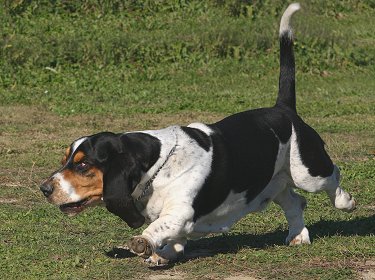
Basset Hounds can always find their way to the food! You have to anticipate and outsmart them.
Safety in the living/family room
- Some dogs find electrical cords to be irresistible and will chew happily on them. "Happily", that is, until their tongue is sliced open or burned from an electrical shock. If you have a puppy (or an adult chewer), hide electrical cords under rugs or furniture, or run them through protective PVC piping. You can also buy electrical cord "tamers" that keep cords jacketed inside protective sleeves.
- Drapery cords can be another irresistible tug toy. Pups can chew off and swallow bits of the cord or become entangled in it and injure themselves trying to get free. Lift drapery cords out of reach until your puppy is older and more trustworthy.
- If you have indoor plants, any plant material your dog eats may produce mild vomiting or diarrhea. But some plants are truly toxic to dogs. See the most current list of toxic and non-toxic plants on the Animal Poison Control Center website. (Some dogs will even chew on silk plants.)
- Few dogs are so dumb as to actually stick their nose into the flames of your fireplace! But a heat-loving dog might lie close enough for his hair to be struck by flying sparks Or he may step on hot ashes Use a fireplace screen so your dog must keep his distance. If he's a chewer, obviously keep your matches, kindling, and firewood where your dog can't get them.
- On low coffee tables food and other forbidden objects (cigarettes, pills, eyeglasses, breakables) can be easily stolen.
Don't underestimate the reach of tiny dogs – they're often clever with their paws! If they can stand up on their hind legs and stretch far enough to touch something on the table with their paw, they may be able to pull it off.
 And then there are the tail-waggers! The vigorous wag of an enthusiastic long-tailed dog can clear a coffee table with one sweep. Then everything on the floor becomes a potential chewable.
And then there are the tail-waggers! The vigorous wag of an enthusiastic long-tailed dog can clear a coffee table with one sweep. Then everything on the floor becomes a potential chewable. - More about toy dogs.... look critically at your furniture, from your tiny dog's eye-level and consider whether it poses any danger. Some tables have sharp protrusions or crossbars running underneath. A romping toy dog could put out his eye or sustain a concussion if he races underneath and conks his head.
Safety in the bedrooms
Don't leave candles, matches, foam earplugs, antacids, etc. on your nightstand if your dog can reach them from the floor or bed.
Many dogs like to drag around your dirty clothes. If that's ok with you, it's ok with me... unless he actually chews the crotch out of your underwear and swallows it. Then he might end up in a veterinary emergency room with a blocked digestive tract. If you have a chewer, make sure your laundry basket has a lid and/or put it out of reach or behind a closed door.
Kids' bedrooms can be particularly dangerous, with swallowable marbles, action figures, blocks, and stuffed animals. Puppies and confirmed chewers must be kept out of these bedrooms.
Safety in the bathroom
 Be careful! Don't leave any pills on the edge of the sink. You might accidentally knock them off and if they land on the bath mat, you won't hear them fall. Even vitamins or ibuprofen can kill a dog.
Be careful! Don't leave any pills on the edge of the sink. You might accidentally knock them off and if they land on the bath mat, you won't hear them fall. Even vitamins or ibuprofen can kill a dog.
Many dogs are drawn to used tissues used tissues, adhesive bandages, and cotton balls. If your pup is a tissue shredder, put the wastebasket up on the back of the toilet, or in the tub behind the shower curtain.
Gentlemen, here's another reason to keep the toilet seat down – so your dog can't drink the water.
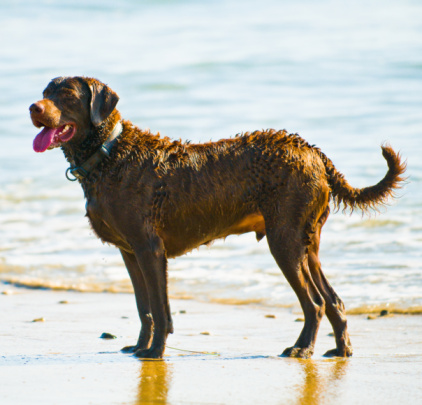
Chesapeake Bay Retriever in his natural element
Safety in the yard and garden
A chemically-treated yard and toxic plants are the obvious dangers. There are plenty of hardy plants you can choose that don't need to be sprayed with insecticides or fungicides, or you can make organic solutions that won't harm your dog.
Is your compost pile secure from your dog rooting around in it?
For the same reason, secure your garbage cans. Use heavy-duty cans with tight lids and/or store the cans completely away from your dog.
 Don't leave garden tools lying around with the tines pointed up so that your dog might step on them and cut his foot.
Don't leave garden tools lying around with the tines pointed up so that your dog might step on them and cut his foot.
Safety on the driveway and walkways
Antifreeze can leak from your car's radiator or spill on the ground while you're pouring it, and pets may be drawn to its sweet taste. So I recommend using antifreeze with propylene glycol (much less toxic) instead of ethylene glycol (highly toxic).
The chemicals in ice melting products are serious irritants to your dog's paws. The pellets get wedged between his toes and prolonged exposure can actually burn his feet. If he licks it off his paws, you may see vomiting or diarrhea, or worse.
Yes, the manufacturers of these products are sticking "Pet Friendly" assurances on the labels, but none of them are safe for pets. The ASPCA Animal Poison Control Center classifies all ice melting products as toxic.
The most dangerous products are those that contain chloride sodium chloride (aka rock salt), magnesium chloride, calcium chloride, potassium chloride. The safest products are those that contain urea unfortunately, urea is lousy at melting ice, so you'll end up using a lot of it, which isn't good for surrounding vegetation.
Honestly, the best thing to do is shovel up as much snow as you can. Then apply a limited amount of ice melter to break the surface tension between the ice and pavement. Give it a little time to work, then use an ice pick to segment the remaining pieces, and a shovel to remove the slush.
This quick removal process gets rid of those nasty chemicals that can burn the feet of passing dogs, cats, squirrels, etc.
Or.... don't bother melting the ice with chemicals, and just use sand or clay kitty litter for traction. That's all we used when I was growing up.
Safety going for walks
Since so many people don't shovel up their ice melting products, you should expect that your dog's paws are walking through a toxic salty slurry. Thus you should rinse his feet after winter walks. Some owners put protective booties on their dogs.
Be aware that dogs can get frostbite just like people can. Your dog's ears, nose, and feet are especially susceptible. After a walk, check his feet for snow or ice balls stuck in the webbing between his toes.
Put a sweater on your dog if he has a thin or sleek coat, if he has just been clipped, if he is elderly, or if he has an illness such as hypothyroidism where he has difficulty maintaining body heat.
Since so many people use the most toxic form of antifreeze, ethylene glycol, don't let your dog drink from a puddle where a car might have parked.
 Since so many people use chemicals on their lawns, be wary of letting your dog romp across grass that looks perfect and pristine with no dandelions or weeds – it's been sprayed.
Since so many people use chemicals on their lawns, be wary of letting your dog romp across grass that looks perfect and pristine with no dandelions or weeds – it's been sprayed.
Be careful walking in hot weather. Dogs can't easily sweat like people do, so heat builds up in their bodies much faster than it does in ours. Dogs can only release heat from their bodies through their tongue (by panting) and their footpads. Heatstroke is especially common in dogs with short faces, heavy coats, or black coats.
Before walking your dog across blacktop on a hot day, reach down and feel the surface with your hand. If it's hot to your bare hand, it will be hot to his bare feet. Pick up your small dog, or run across quickly (if it's a short distance), or find another route.
Safe collars & leashes
Read my article on leash-training, which includes my recommended (and not recommended) collars and leashes.
I do urge a special caution about using a "retractable" leash. If you use one, don't abuse it. Many people allow their dog to roam at the end of a long retractable leash, even around other people or other dogs. This is not responsible pet ownership.
Use retractable leashes sensibly. You can allow full leash length in open fields or parks or along quiet roads. But when people or other dogs are passing by, or when you're walking on or near a road with traffic, shorten the leash so that your dog is close beside you and fully under control.
Safety against getting lost
ID Tag
When someone finds a loose dog, they look for an ID tag. If it has a personal phone number on it, they will usually take a minute to call.
A license or rabies tag is not enough!
Most people will NOT call Animal Control or a vet to track down a license number or rabies tag number. It's too much hassle. They'll rationalize... "Ah, he probably lives down the street. His owner will be annoyed if he has to go to the pound to get his dog. And I'm supposed to hang around here waiting for Animal Control to show up? Nah, I'll let him go on his way, he'll probably find his way home."
So get your dog an ID tag with your phone number. I've had good luck with plastic reflective tags from Lucky Pet ID Tags. I prefer plastic because they make less noise than metal. I also prefer a very small tag, even on large dogs, so it doesn't annoy the dog by bumping against his neck.
Pro Tip: Have the company engrave "I'm lost!" along with your phone number. The "I'm lost!" may convince a potential Good Samaritan that this dog shouldn't be wandering. If there's space, include a second or even third phone number.
Whether to include your dog's name is controversial. Hearing his name might reassure a nervous dog. On the other hand, if the dog becomes too responsive, the finder might decide to keep him!
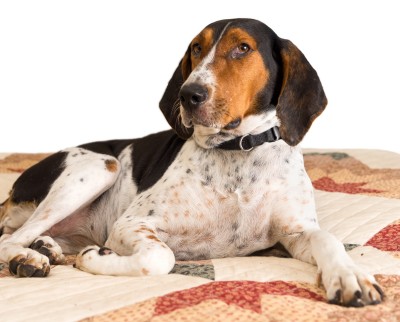
Coonhounds are wanderers, so be sure your fences are secure
Microchip
One weakness of an ID tag is that it doesn't do any good if your dog's collar comes off. A microchip, on the other hand, is permanent identifications that stays with your dog forever.
A microchip:
- is a tiny transponder, about the size of a grain of rice
- is implanted (by your vet) with a hypodermic needle under the loose skin atop your dog's shoulders. No sedation is needed.
- has no power supply or battery. Its electronic circuitry is only activated if it is scanned.
- bonds itself into place under your dog's skin, so it doesn't move around.
- is inexpensive – $25 to $75 for insertion, plus about $25 for lifetime registration
How a microchip can bring your lost dog home
Most animal shelters have a microchip scanner which they wave across the back of each dog who comes in. The scanner emits safe, low-frequency radio waves that activate the microchip, which sends your dog's unique ID number to the scanner's view window. The shelter then contacts the national database where that ID number is registered, and voila! you get a phone call!
The microchips I recommend
There are a number of microchips, but many of them are flawed and inferior. I only use chips made by AKC Reunite (their Trovan chip), HomeAgain (their Destron chip), or Avid (their Avid chip). Most vets carry at least one of those three chips. Don't settle for less.
Once the chip is implanted, it must be registered! Failing to register their dog's chip is a huge mistake some owners make. A chip that isn't listed in one of the major databases is useless.
The microchip registries I recommend
There are lots of registries vying for your business, but most of them are fraught with problems. The free ones sound appealing, but who knows when they'll go out of business? I stick with the oldest registries:
- If my dog got the AKC chip, I register it in the AKC Reunite database for a one time fee of about $25.
- If my dog got the Avid chip, I register it in BOTH the AKC Reunite database (one time fee, about $25) AND in Avid's PETtrac database (one time fee, $35).
- If my dog got the HomeAgain chip, I register it in both the AKC Reunite database (one time fee, about $25) AND in HomeAgain's database (one time fee, $20).
Safety around other strangers and other dogs
- When you go for walks or take your dog anywhere, you're likely to encounter other people and/or other dogs.
- You might wonder what you should do if the two of you are approached by, say, a strange dog who is not on a leash.
- You might wonder if you should ever allow your dog to sniff noses with another dog.
 You might wonder if it's okay if your small dog plays with a larger dog.
You might wonder if it's okay if your small dog plays with a larger dog.
How to handle all those interactions is covered in my article on socialization.
Safety around cats and other animals
When it comes to cats, there are three safety concerns.
 Cat-chasing can become an obsession.
Cat-chasing can become an obsession.
Dogs who become enthusiastic about cat-chasing will dash through open doors, leap from car windows, climb over fences, and rush heedlessly across the street. Since you never know when a cat may appear from the shadows, cat-chasing dogs are risky to take anywhere.
- Your dog could injure or kill a cat.
Some dogs become deadly serious about stalking cats. If your neighbor's cat is injured or killed by your dog, not only is this a tragedy for the cat, but also you will end up paying the medical bills and your neighbor may retaliate by seeing that some "accident" befalls your dog when you're not home.
- The cat could fight back.
 Most dogs chase just for the fun of it and will put on the brakes and beat a hasty retreat if the cat suddenly turns to confront them. But if your dog can't get out of the way in time, a big ol' tomcat can cause nasty damage.
Most dogs chase just for the fun of it and will put on the brakes and beat a hasty retreat if the cat suddenly turns to confront them. But if your dog can't get out of the way in time, a big ol' tomcat can cause nasty damage.Cat teeth and claws carry LOTS of bacteria, so cat scratches and bites are likely to become infected. And a dog who is hurt by a cat may develop psychological fears and neurotic behaviors.

Border Terrier, high-energy lover of the outdoors, with strong chasing and prey instincts
Chasing small animals
It's tempting to send your dog chasing after pesky squirrels or rabbits who dig holes in your garden or monopolize your bird feeders.
But as we've just seen, chase-oriented dogs risk injury (or worse) when they forget their boundary training and self-control. They dash through open doors, pull you into the street, slip their collars, jump out of your car, and so on.
Dogs who are allowed, even encouraged, to chase other living things usually do so at the worst possible time. Then they never chase anything again.
Some animals fight back. A cornered raccoon can be absolutely ferocious. And need I mention the dismaying consequences resulting from encounters with skunks or porcupines
Better to teach your dog to "live and let live."
Birds of prey
- Great Horned owls are especially aggressive and will attack rabbits, skunks, kittens, puppies, and adult toy dogs. A neighbor of mine lost her Yorkshire Terrier to a Great Horned owl.
- Golden eagles weigh up to 10 pounds and will attack cats and small dogs. Bald eagles might go after a very small puppy or kitten.
- Red-tailed hawks weigh up to 3 pounds and might attack a pup of about the same size.
If these birds live in your area, don't let your toy dog (or a small puppy of any breed) run loose in a large open yard – especially in the evening when Great Horned owls are on the prowl. Stay right beside him if he needs to go outside at night.
Coyotes
In some parts of the country, coyotes are so prevalent that you should never let a small dog outside alone.
Toads
If your dog mouths a toad, the toad will protect itself by secreting a toxin from its skin. Toxins from most toads simply cause your dog to drool or vomit. But the Colorado River toad (SW US) and the Marine Toad (Florida and South Texas) can kill a dog with their potent poison. If you live in these areas, be on the lookout for these toads.
Creepy crawly creatures
Dogs can be stung by bees, wasps, and scorpions, or bitten by spiders and snakes. And just as with people, the reaction varies from mild pain and swelling, to life-threatening anaphylactic shock and collapse. Clear away hives and nests, and also brush piles where scorpions and snakes might hide.
Safety riding in cars
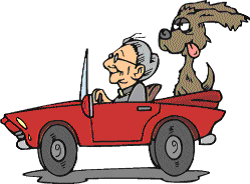 If you allow your dog to ride loose in the car, you're putting the dog, yourself, your passengers, and every other person on the road in danger.
If you allow your dog to ride loose in the car, you're putting the dog, yourself, your passengers, and every other person on the road in danger.
A loose dog may CAUSE an accident by jostling your arm. Or his antics may distract you from paying full attention to the road.
In a crash, a loose dog becomes a deadly projectile. Even a small Miniature Schnauzer, because of momentum, becomes the equivalent of a Saint Bernard hurtling forward with enough force to fracture the skull or break the neck of you, your spouse, or your kids.
The Institute for Highway Safety says, "After the collision outside the car, there are always collisions inside the car. Both wreak havoc."
 Often the victim is the poor dog himself as he smashes against the windshield or is flung through an open or shattered window or through a door that has popped open on impact or yanked open by rescue personnel. Now your terrified dog is loose in traffic, where he will become lost or hit by another car.
Often the victim is the poor dog himself as he smashes against the windshield or is flung through an open or shattered window or through a door that has popped open on impact or yanked open by rescue personnel. Now your terrified dog is loose in traffic, where he will become lost or hit by another car.
Please, if you truly care about your dog, secure him in the REAR seat:
- with a special canine harness and seat belt like the Ruff Rider Safety Harness
- or in a crate that has itself been buckled into the rear seat so IT can't hurtle around the car during a crash.
Your dog should never ride in the front seat. Airbags blast out of the dashboard at a fearsome speed that can kill a dog.
Teach your dog to stay in the car even when the door is open
When you get out of the car, you should be able to open any car door without your dog immediately jumping out. He doesn't RIDE loose in the car, of course – we've already talked about that. But at some point, you will have to unbuckle his seat belt or open the door to his crate. That's when the "Wait!" command comes in handy. Teach it!
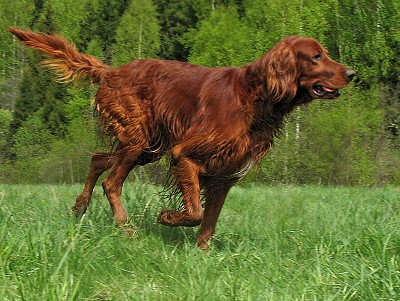
Irish Setter
Don't leave your dog in the car alone
You've heard all the warnings about not leaving your dog in a hot car. What you may not know is "How hot is too hot?"
On a mild 75-degree day, the temperature inside a car with the windows cracked can reach 120 degrees in 30 minutes. On a mild 75 degree day!
A dog doesn't have all the sweat glands we have. He can only sweat through his tongue (by panting) and through his paw pads.
When he has only hot air to breathe, his body temperature climbs so rapidly that he is unable to lower it simply by sweating through his tongue and paws. That means he is going to overheat, suffer heatstroke, and probably die.
If you see a dog panting in a car on a hot day, quickly check the closest store and ask the manager to page the vehicle's owner. Then call the police, who usually respond faster than Animal Control.
Other reasons not to leave your dog in the car alone:
- He could be stolen. Imagine what that would feel like to come outside and discover your dog gone from your car.
- He could annoy everyone by barking, especially if another car with a dog happens to park nearby.
- He could be harassed by passersby. Trapped in a small space where he can't escape, he may be terrified or become agitated and defensive.
- Or HE could be the one to initiate the aggression, lunging and barking at passersby. No, a lunging barking dog is not "protecting his property" or "being a good watchdog". A sensible protective dog doesn't threaten people just because they walk near the car.
A dog who lunges and bellows at people simply because they walk by the car, or look at him through the window, or open the door of the car parked beside yours is an indiscriminate nuisance. He is annoying everybody, he is creating a terrible impression for his breed, and he is forming a bad habit of mindless aggression.
Safety flying on airplanes
The only dogs who can fly in the cabin with you are service dogs, and very small dogs whose carrier can fit under your seat.
Every other dog must travel down in the belly of the plane as baggage or air cargo. Sometimes that works out okay. But you should know the risks:
- Flying is very stressful for a dog. The baggage and cargo holds are temperature-controlled and pressurized, yes. But the experience is still frightening to a dog who is alone and cannot understand what is happening. Waiting in the terminal, with the rumble of forklifts and flinging of boxes and suitcases, bouncing along on the baggage cart, being loaded onto the plane, are especially stressful.
- Flights can be delayed or connecting flights missed. Your dog's crate may be misplaced, left behind, or loaded onto the wrong plane. He may be left in the sun on a hot tarmac runway. He may be left in a frigid warehouse.
- His kennel may be handled roughly or dropped. He may break out of his kennel and escape. He may be released from his kennel and disappear.
Because these tragedies happen more often than you might think, I no longer allow a dog to fly unless he's in the cabin with me.
Safety around water
Swimming pools
The dog paddle is an instinctive swimming motion for most living creatures who find themselves in deep water. Most dogs don't drown because they can't SWIM – they drown because they can't get out of the water.
"But my pool has steps...a ladder...a ramp..."
Well, that's all well and good if your dog doesn't panic.... which he is very likely to do.
When a dog suddenly falls into deep water, he usually turns around and tries to get out the SAME way he got in. It is NOT natural for a dog to paddle calmly around looking for the "right" way out.
When he is suddenly swamped with adrenaline, he is unable to think clearly and will simply flail his front paws at the spot where he fell in. If that's a steep slippery wall, he is likely to stay right there, flailing desperately until he becomes exhausted and drowns, never once having looked across the pool at the steps, ladder, or ramp.
So if you own a dog and a pool...
- Show him the way out of your pool and have him practice using it. Repeatedly.
- If possible, fence your pool. Or fence your DOG so he can't go near the pool when you're not right there to supervise.
- Consider buying a Safety Turtle, a small electronic device that attaches to your dog's collar. If it becomes immersed in water (i.e. if he falls in the pool), an alarm sounds in your house. It's around $200, but may be worth it to you.
Boating
Every dog should wear a life jacket on a boat. It's just too easy for him to fall overboard.
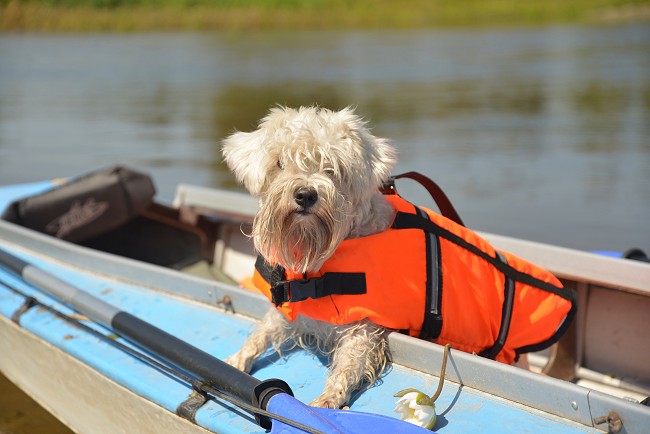
Having a great time.... safely!
Safety during the holidays
The 4th of July
More dogs are lost around the 4th of July than any other time of year. Why?
Fireworks.
There's something about the fizzy sparks and sudden explosion that terrifies many dogs. One of my own German Shepherds, who excelled in protection sports and ignored gunshots, disliked the sound of firecrackers and would try to hide in the basement.
It is the height of folly to leave your dog outside around the 4th of July. Even the calmest dog may hear a firecracker in the distance and panic – even if he has never reacted to firecrackers before – and flee over or under or through the fence.
Keep your dog indoors around the 4th of July. If you must leave the house, lock him securely in his crate. Frightened dogs have broken through windows or torn up the house in their attempt to escape.
Halloween
If your dog is outgoing and trusting, he might find this holiday FUN because lots of children – new friends! – come to the door. My Miniature Poodle, Buffy, loves Halloween!
 But if your dog is suspicious or timid, he might view these scary-looking creatures as threats. He might bark and bark and still the intruders keep coming, which makes his stress levels skyrocket.
But if your dog is suspicious or timid, he might view these scary-looking creatures as threats. He might bark and bark and still the intruders keep coming, which makes his stress levels skyrocket.
A dog who is not fond of Trick or Treaters should be put in his crate in a back room. This will keep the kids safe and your dog calmer and under control.
It's never a good idea to leave your dog outside alone. But it's especially risky on Halloween. He could become the target of juveniles playing "pranks."
Even worse, in some parts of the country, he could become the target of cults who engage in bizarre rituals in which animals are butchered. Black dogs (and cats), in particular, are at highest risk for "disappearing" around Halloween.
Thanksgiving
 The obvious threat is your dog getting hold of a cooked turkey bone. Cooked bones can choke your dog, puncture his throat, or obstruct his digestive tract.
The obvious threat is your dog getting hold of a cooked turkey bone. Cooked bones can choke your dog, puncture his throat, or obstruct his digestive tract.
Close behind is eating rich greasy leftovers that can cause a potentially life-threatening illness called pancreatitis Veterinary emergency rooms see lots of pancreatitis victims over the Thanksgiving holidays.
That doesn't mean your dog can't partake of your holiday meal. As long as he is used to eating real food, his digestive system will have no difficulty digesting wholesome leftovers.
Wholesome, I said! A couple of bites of plain turkey meat and a small scoop of squash or sweet potato – unsalted and unbuttered. NO gravy. NO stuffing. NO dinner rolls. NO pies. Nothing with butter, sauces, or spices.
Christmas
 Tipsy trees. Anchor the tree in a sturdy stand. Be aware that live needles cannot be digested and can puncture the throat or intestines.
Tipsy trees. Anchor the tree in a sturdy stand. Be aware that live needles cannot be digested and can puncture the throat or intestines.
Ornaments and tinsel. If you have a chewer, fasten decorations firmly to branches or hang them only on higher branches. Or surround the tree with a decorative fence, or keep your dog out of the room. Lots of ways here to prevent disasters!
Wrapping paper, bows, ribbons. Every Christmas, dogs are presented to emergency room vets with these festive items strangling their intestines.
Speaking from experience.... I recommend not allowing your dog to "unwrap" presents! It looks cute, but you might come home one day to a pile of happily shredded presents under the tree. It happened to me when I was a teenager with a young German Shepherd!
UNwrapped presents. After you open and admire a new gift, watch where you set it down. It may look like an inviting new toy to your dog. Children's toys are especially dangerous, as they often contain small parts that you might not notice are missing.... until the dog starts vomiting.
Desserts, potpourri, incense. Don't leave your dog in a room unattended if there are tempting sweets or fragrant candles on the coffee table. The scents may also make him sneeze or cough. You and I have 5 million scent receptor cells. Your dog has over 100 million. The canine olfactory system is extremely sensitive, so it's just unkind to overwhelm it.
Christmas plants. If your dog nibbles on Christmas cactus, hemlock, holly, ivy, mistletoe, or poinsettia, the results can range from a mildly upset stomach to seizures and death. Keep these plants away from pets!
Unhealthy gifts for your dog. Well-meaning friends and relatives may give your dog unsafe or unhealthy gifts, such as flimsy stuffed animals, rawhide chews, or a box of supermarket treats. Find a diplomatic way to keep such things away from your pup.
Safety when you visit friends and relatives
Visiting is a major part of holidays.... and other times of the year, as well. But if you bring your dog along, don't get so caught up with visiting that you forget his safety. Remember, a dog is a toddler!
Don't let him loose in someone else's house until you're sure that...
- All doors to the outside are closed and secure.
- The floors are not slick and slippery, especially if your dog is a clumsy adolescent or arthritic senior citizen.
- There isn't anything toxic or chewable that he could get hold of – mouse traps, kids' toys, rawhide chews, chocolates on the coffee table.
It's always safest to keep your dog on-leash in other people's houses. There are too many potential dangers in a home that hasn't been carefully dog-proofed like yours has.
And don't let your dog loose in someone else's yard until you're sure that...
- Fences and gates are high enough and secure.
- They haven't spread pesticides on the lawn or snail bait in the garden.
- Garden tools or other sharp objects aren't lying about.
- Garbage cans are lidded or out of reach.
- There isn't an aggressive dog next door.
Walk around the yard and look for yourself. Don't accept reassurances from people who haven't read this book. They have good intentions, but they're unaware of important canine safety issues.

Lovely family of Lhasa Apsos
Safety when friends and relatives visit YOU
If you have guests, especially long-term guests, teach them about canine safety. Make sure they understand that they...
- Should close all doors and gates firmly.
- Should close all cabinets and cupboards firmly.
- Should close their bedroom door to keep the dog out.
- Shouldn't give your dog anything to eat. Tell them he's on a strict veterinary diet.
But don't rely on them to remember! Keep tabs on them yourself. Check the floor to make sure they haven't dropped stuff that your dog may eat. Make sure the doors to their rooms are closed. Double-check that your front and back doors are always closed, along with your outside gates.
- Don't let anyone take your dog for a walk unless you go with them.
 Guests don't know your neighborhood. They don't know where the loose dogs are, or the dogs who charge the fence when you walk by, or the teenagers at the corner of Elm Street who think it's funny to scare passing dogs by whooping it up and pretending to throw things.
Guests don't know your neighborhood. They don't know where the loose dogs are, or the dogs who charge the fence when you walk by, or the teenagers at the corner of Elm Street who think it's funny to scare passing dogs by whooping it up and pretending to throw things.Guests don't know your dog. Maybe he's leery of passersby wearing beards or hats. Maybe he has a bad habit of trying to drink out of puddles (remember antifreeze?) or trying to eat junk off the sidewalk. Maybe he lunges after squirrels and could pull the leash right out of your startled guest's hand.
Guests may not know how to control your dog properly around other dogs. What happens if your dog – or an approaching dog – acts aggressively?
Be especially vigilant with tiny dogs.
Leading causes of death in toy dogs are accidents and injuries. Small dogs are especially at risk when they're around people who don't understand just how fragile they are.
- Remind your guests to watch their step. Most toy dog adults are quick and agile and have learned to avoid being stepped on. But toy dog puppies don't have that experience or coordination.
Safety tip: Trade heavy boots for slippers and shuffle your feet low to the floor around toy breed puppies.
- Remind your guests to NOT give your dog anything to eat without checking with you first. Most people offer bits of food that are too large for a toy dog to swallow.
Chocolate is especially deadly to tiny dogs. If your guest leaves a Hershey's Special Dark Bar on the arm of the sofa and your 6-pound dog eats it, he'll die.
- Remind your guests to NOT pick up your toy dog. Toys tend to lie deceptively still in your arms, then suddenly push off with their hind feet against your chest, launching themselves into space and ending up with a broken leg or concussion.
Instead, ask your guest to sit down on the couch and wait until your toy dog climbs into their lap on his own... if he chooses to!
Protect your dog from being stolen
 People who pay you a visit are not always friends and relatives.
People who pay you a visit are not always friends and relatives.
Having someone take your dog is a nightmare that will leave you overcome with shock, grief, and guilt.
Why your dog might be stolen
- For money. The thief may sell the dog, or else wait for a reward to be posted, then call and report they "found" him. It's still a horrible experience, but at least you get your dog back.
- For the illegal, underground dog fighting industry. Medium-sized and large dogs may be stolen to serve as "practice opponents" for seasoned fighting dogs. Small dogs may be stolen to serve as helpless "bait" to be ripped apart, thereby increasing a fighting dog's prey instinct and aggression.
- For breeding. The thief may want your dog for his own breeding purposes or he may deliver your dog to a puppy mill.
- For experimental research laboratories. The USDA gives people licenses to sell animals to research laboratories. USDA regulations require these people to obtain their animals from breeders or dog pounds, but some unscrupulous dealers get their dogs from thieves or from "scouts" who scour the country responding to "Free to good home" ads. The dealer then transports these unfortunate dogs to a research lab hundreds of miles away.
- For cult rituals. Dogs may be stolen for sacrificial rituals, especially around Halloween, and especially black dogs. Their butchered bodies are often found later in the woods.
- To keep for their own. Someone may simply notice your dog and find something about him appealing.
 Frustration. Upset neighbors may steal a dog who barks too much or who pees on their lawn. They may drive your dog to another city and set him loose or give him to a rescue group.
Frustration. Upset neighbors may steal a dog who barks too much or who pees on their lawn. They may drive your dog to another city and set him loose or give him to a rescue group.
Honestly, dogs who bark all day are so annoying that normal law-abiding people can be driven crazy. If you go to work and leave your dog barking where YOU don't have to listen to him – but everyone else does – don't be surprised if you come home one day and he's gone.
How to prevent theft
- Never leave your dog unattended in the yard. Dogs who are stolen are almost always outside, unsupervised.
- With your dog safely indoors, lock your doors when you leave him alone. Drop a security brace into the channel of your sliding doors and windows.
- Never leave your dog unattended in a car. He is vulnerable to heatstroke, harassment – and theft.
- Never leave your dog unattended in front of a store or bank. Don't tie him to a lamp-post while you go in "for just a minute." It takes only a minute to untie a dog and pop him inside a car.
- Whether true or not, tell everyone your dog is neutered. Whenever anyone admires my dog, I try to work this into the conversation: "Yeah, we thought about breeding her, but then we decided No, so we had her spayed so she can never have puppies."
- Never brag about your dog to strangers. Don't tell people how much your dog cost, how "rare" his breed or color is, or how many ribbons he has won at dog shows.
In other words, don't make your dog seem desirable to a would-be thief.
- Protecting your dog also means keeping him quiet and well-behaved so he doesn't drive your neighbors to do dreadful things just so they can have some peace. Don't let him bark and bark. Don't let him go to the bathroom on your neighbor's property. Don't let him act aggressively toward your neighbor's kids or your neighbor's pets.
Don't give people a reason to want your dog gone!
- Have your dog microchipped. It won't prevent theft, but it may keep him out of research laboratories, which are supposed to scan dogs before accepting them. And if he somehow ends up in a shelter, they'll scan him.
- Take current photos of your dog, which will help you find him and prove ownership. Go over him from head to toe and write down identifying traits: two white toenails on right front foot, heart-shaped white spot on chest, scar on left ear, crooked tooth in lower jaw. Take close-up photos of each unique trait.
Consumed by guilt and grief
Trying to find a stolen pet can consume most of your waking hours, day after day – for weeks, months, even years. Your family and friends will eventually encourage you to give up, adopt another dog, get on with your life.
 But you will remain haunted by the endless questions and worries: Is your dog alive? is he being abused? is he cold? hungry? confined in a puppy mill cage? being subjected to torturous research experiments?does he ever think about you and the wonderful home he had? does he wonder why you've abandoned him?
But you will remain haunted by the endless questions and worries: Is your dog alive? is he being abused? is he cold? hungry? confined in a puppy mill cage? being subjected to torturous research experiments?does he ever think about you and the wonderful home he had? does he wonder why you've abandoned him?
Your grief and guilt may never go away.
The only guarantee against pet theft is to watch your dog just as carefully as you would watch your child.
Safety during natural disasters
Hurricanes, tornadoes, wildfires, floods, earthquakes. In the wake of natural disasters, rescue organizations move swiftly to assist people but pets may be left to fend for themselves.
Many emergency shelters don't allow pets. Small wonder, then, that so many people refuse to evacuate their homes if it means leaving their pet behind. Our pets are part of our family. They depend upon us to protect them. Don't abandon your pets!
Fortunately, more and more emergency shelters are starting to allow pets. You should also make up a list of pet-friendly motels in your area.
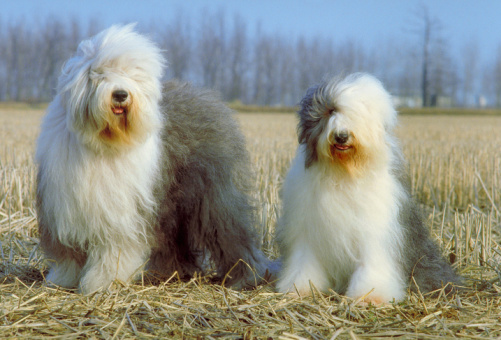
Old English Sheepdogs – you either gotta brush them daily or clip the coat short so it stays neat, clean, and unmatted
Your OWN accident or death
What will happen to your beloved dog if you're seriously injured in an accident? You may be unconscious or otherwise unable to communicate, so you should take steps right now to arrange for your dog's care.
- Find at least two friends or relatives who assure you that they'll provide emergency care for your dog or will contact caregivers (such as your pet sitter). Give them keys to your home, or tell them where keys are hidden.
- Write out your feeding and care instructions (including medications) and post it on your fridge.
 If you have multiple pets, include a picture and identifying information beside each name so they can be easily distinguished by people who don't know them.
If you have multiple pets, include a picture and identifying information beside each name so they can be easily distinguished by people who don't know them.- Make a brightly colored "Pet Alert" card and carry it in your wallet so it can be found by emergency personnel. List the types and names of your pets, and the phone numbers of your vet and emergency caregivers.
What will happen to your dog if you DIE?
In their wills, many pet owners leave money to a friend or relative who has agreed to care for their pet. But there's no guarantee the money will be used that way. Some caretakers have actually euthanized pets and used the money for themselves.
A safer method of leaving money for your pet's care is to set up a legally-binding trust fund. All 50 states now allow this. You write out specific care instructions and appoint a trustee who will oversee your chosen caretakers to make sure they are taking care of your pet in the manner you specified.
This can be expensive, though. You need to pay an attorney to set it up, and there will be annual administrative costs for the trustee to monitor your caregiver.
How much money should you leave? Add up your dog's feeding and health care costs per year, and multiply by the remainder of your dog's expected lifespan. Then add some extra money as a margin of safety.
A few miscellaneous things to worry about!
Falling objects
Dogs can be injured by things that fall or things that are dropped. Hold pots and pans firmly so they don't fall on your dog's head. Don't prop shovels or rakes where they could be knocked over. Walk through your rooms looking for things that might fall – tipsy pedestals, for example.
If you live in earthquake country, make sure there's nothing immediately over your dog's regular sleeping area that could fall – for example, a shelf of heavy knickknacks, a heavy painting, or a mirror on the wall above his bed.
Falling DOGS
Every year dogs suffer broken ribs, broken legs, and concussions from falling off balconies, decks, and open stairwells.
If possible, put up protective fencing. If it's already fenced but the openings between the slats are wide enough for your dog to squeeze through, add a strip of plexiglass or lightweight mesh/netting.
ONE LAST CAUTION about neighbors
I'd like to repeat my warnings NOT to let your dog irritate your neighbors. In this day and age, people are so harried that they "snap" more easily than in the past.
Annoyed neighbors...
- WILL let dogs out of their yards, to be lost or hit by cars.
- WILL steal dogs and release them in another city.
- WILL poison dogs with meat soaked in rat poison.
- WILL shoot dogs with BBs or bullets.
Keep your dog quiet. Keep him on your own property. Don't let him harass the neighbors, their kids, or their pets. Don't let him damage anything that belongs to them.
And ONE FINAL SCAN for chewables
Develop the habit of automatically scanning the floor and ground. Train your eye to spot the most innocuous things: safety pins, rubber bands, staples, tacks, string.
Dogs are curious and impulsive. They run in every direction, oblivious to danger. They poke and explore. Remember.... raising a dog is like raising a toddler who never grows up.
My best-selling books – now available FREE on my website
 Respect Training For Puppies: 30 seconds to a calm, polite, well-behaved puppy is for puppies 2 to 18 months old. Your puppy will learn the 21 skills that all family dogs need to know. Click here to read for free.
Respect Training For Puppies: 30 seconds to a calm, polite, well-behaved puppy is for puppies 2 to 18 months old. Your puppy will learn the 21 skills that all family dogs need to know. Click here to read for free. Teach Your Dog 100 English Words is a unique Vocabulary and Respect Training Program that will teach your adult dog to listen to you and do what you say. Click here to read for free.
Teach Your Dog 100 English Words is a unique Vocabulary and Respect Training Program that will teach your adult dog to listen to you and do what you say. Click here to read for free. 11 Things You Must Do Right To Keep Your Dog Healthy and Happy helps your dog live a longer, healthier life. Get my honest advice about all 11 Things before you bring home your new puppy, because some mistakes with early health care cannot be undone. Click here to read for free.
11 Things You Must Do Right To Keep Your Dog Healthy and Happy helps your dog live a longer, healthier life. Get my honest advice about all 11 Things before you bring home your new puppy, because some mistakes with early health care cannot be undone. Click here to read for free.
